(Previously…….’Thoughts on Fly Fishing – Fly Lines’)
I started getting really serious about fly-fishing just after I migrated to South Africa in 1967. Before then, fly-fishing had been no more than a pleasant interval between serious coarse fish specimen hunting expeditions.
What eventually developed over there was the fact that for over 15 years of my life I did all of my fishing with a fly rod in my hand, and not just in search of trout either. These days I also fly fish more often than using other methods; here’s how I go about it:
The vast majority of my fly-fishing is confined to the pursuit of rainbow and brown trout on medium to small reservoirs and other types of still water. These are the fisheries most available to me. Let’s have a look at the tackle I use:
Rods
My current “Bread and Butter” rod is a 9 ½ foot weight 7 Greys G-TEC rod which has a fairly fast action, throws a 7 weight forward taper line an incredible distance, yet is forgiving enough to handle light leaders and tippets down to 3 lbs test. What I like most about this rod is that it is incredibly light at just under 4 ounces and is finished matt without any shiny varnish, which is designed to spook fish!
Well, for what other reason would one finish a rod like this?
My other rods are a 10 foot Greys Platinum XD 7 weight, the extra length being perfect for boat fishing, and a 9 foot Greys 5 weight Streamflex which is great for light tackle work on small still-waters and rivers. If I spent more time on rivers and streams I would probably acquire an 8 foot split cane rod for short accurate work. Yes, I said that right – a split cane rod, but we’ll not go into the reasons for that now.
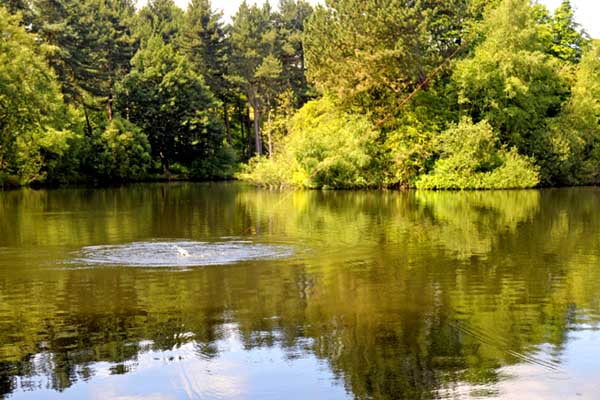
Reels
I like the concept of large and mid arbour reels with the capability of taking lots of low cost “cassette” type spools. All my reels have one-way adjustable drags and are as light as possible. Some of the very expensive fly reels are incredibly heavy and whilst they might be just the ticket on the bonefish flats, they are wrist breakers when used for the average run of trout fishing.
The best trout fly reel I have seen recently in terms of engineering excellence and value for money is the Vision Koma with the low cost cassette spools. Some anglers have expressed doubts as to the suitability of these reels for dropping on concrete dam walls. But since I use fly reels for fishing, these obscure properties matter little.
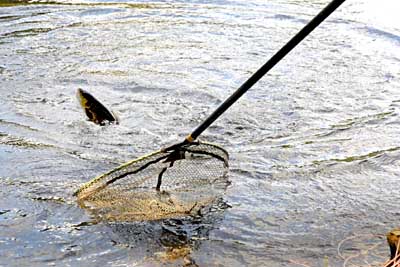 Lines
Lines
I am terribly fussy when it comes to lines. My ideal floating line would float well, cast well, have zero stretch, low memory, have a matt finish and be the colour of cow dung. Unfortunately it is impossible to buy such a line at any price, but if more of us continually nagged the fly line manufacturers, we just might get what we want. It is possible to dye a floating line a dark brown colour of course, but in this day and age it is a hassle we can do without.
I own too many fly lines! I seem to get taken in by the claims of some manufacturers over what their lines can do and then when they don’t do what they claim, the line gets consigned to the rubbish bin.
Recently however, a British manufacturer has produced a range of floating fly lines that meet most of what I believe we as fly fishers want, except that it is a bright “puce” in colour!! It appears that such colours appeal to the “Joe Soap” fly fishers more than mucky cow dung and as sales and profits are more important than fish catching capabilities, it could be many years before we see fly lines in the right colour!
I thought that the colour of floating fly lines had been sorted years ago when Dick Walker stated logically the reasons for dark coloured lines. And more so, when underwater photographs proving the need for dark coloured floating fly lines appeared in their groundbreaking work – “The Trout and The Fly” by John Goddard and Brian Clarke.
I truly wish more line manufacturers would look carefully at these photographs.
But do I use dark coloured floating fly lines? And have I noticed an improvement in catches by doing so? Yes – I have. Certainly I do not have any problem seeing a dark coloured line at the distance I can cast and if you can’t see the line, it’s as good a reason as any to put a bung on your leader. And you needn’t have the whole of your line a dark colour; the length of the belly would be enough.
And if the line has zero stretch, you can feel the majority of takes, even from extremely spooky trout.
As regards sinking lines, well all I can tell you is to buy Airflo – a British company who make the best sinkers and intermediates in the world, and at nearly half the price of some of the best American lines. The reason they are the best is that they are low stretch and have accurately controlled sinking rates along the whole length of the line, something that their competitors cannot equal. Airflo even supply a sinking line that sinks belly first – on purpose of course.
I have two Airflo intermediate lines, a Fast Glass and a Slow Glass, together with a DI 5 and a DI 7 fast sinker. I must say I don’t use them much these days but when I need them, I really do need them.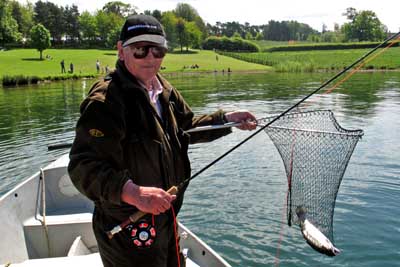 Leaders
Leaders
This is the bit of monofilament that is fastened to the front of a fly line to which the fly or flies are attached. These days I use fluorocarbon in 4lb 5lb 7lb and 9lb tests. All I do is make a figure of eight loop in a length of fluorocarbon and loop-to-loop it to the braided loop on the fly line.
I am extremely fussy regarding the quality and make of the fluorocarbon I use as there still is a lot of rubbish around, especially at the cheaper end of the market. Cheap and nasty fluorocarbon has given the product a bad name, make no mistake about that. Also, be aware that some of the more common knots are not ideal with fluorocarbon. The best three knots are the four-turn half blood for attaching flies, the three-turn water or surgeons knot for droppers or joining two pieces of fluorocarbon and the ordinary figure of eight loop.
So what are the advantages of fluorocarbon to the fly fisher?
1: Invisibility – you have only to put a length of fluorocarbon under water to see this for yourself. It’s not INVISIBLE as some makers claim or infer in the trade names they call it, but it certainly is LESS visible.
2: Stiffness – this helps with turnover and presentation of the fly. I find that presentation of the fly is often the difference between blanking and bagging these days, especially if you use a 3 fly leader. Most good fluorocarbon lines have low memory, which also helps with presentation.
3: Weight – fluorocarbon is quite a bit heavier than nylon and other monofilaments, which helps the leader to break through the surface film. This is extremely useful when using dry flies, as a floating leader next to the fly will scare a trout like nothing else I know. But even so it’s a good idea to carry a tin of degreaser with you – Ledasink being probably the best.
Flies
I tie virtually all my own flies, and I would advise anyone who is interested enough and wants to be successful at fly-fishing to do the same. Once you have learned a few tying techniques, your own flies will be far more successful than anything you can buy. You will also be able to experiment and devise many flies of your own, it’s a fascinating hobby all in itself. As regards what flies I use, I can divide them into 3 distinct categories:
1: Imitations or suggestions of insects
2: Imitations of bait-fish.
3: Outright lures that don’t imitate or suggest anything but which capitalize on the predatory and aggressive nature of the species of fish I am after.
Most of the time I use flies, which fit into category 1. Now is not the space or time to delve into the whys and wherefores of trout fly design, except to point out further reading:
Trout Fly Recognition – John Goddard
Trout Flies of Stillwater – John Goddard
Both the above volumes are standard works on the subject. There are many other books, which will point you in the right direction.
Fly School Notes – Steve Parton
The Fly Tying Bible – Peter Gathercole
I learned to tie flies using a pair of pliers fastened into a vice on the bench of my Dads garage. These days I use a rather sophisticated American Griffin cam vice together with a good selection of materials and tools, which you build up over the years. Tying flies is far more entertaining than watching the usual boring TV programmes these days.
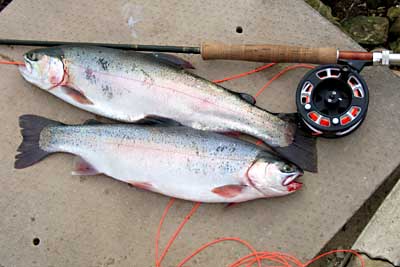
Odds and Sods
For a typical days fly-fishing I will in addition to the above, carry the following:
Folding Landing net, one of decent size.
A priest for killing the fish.
A pair of scissors and long nosed pliers kept on a zinger. I often use the pliers to debarb the hooks my flies are tied on, although these days this operation is done more effectively by squeezing the barb down in my fly vice.
Gerkes Gink for making dry flies float. It is the best floatant around bar none.
Dick Walker’s Ledasink.
Spools of fluorocarbon for leaders.
Fly Casting
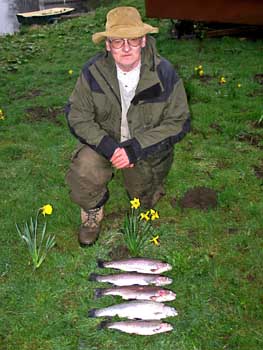 The single biggest hurdle the beginner to fly-fishing has to overcome is learning to cast. There are no shortcuts to jumping over this hurdle unfortunately and it is probably best to book a course with a professional casting instructor. It will probably cost you less than a decent fly rod, and it will be money well spent.
The single biggest hurdle the beginner to fly-fishing has to overcome is learning to cast. There are no shortcuts to jumping over this hurdle unfortunately and it is probably best to book a course with a professional casting instructor. It will probably cost you less than a decent fly rod, and it will be money well spent.
I was one of those self taught casters who had a few tips from two of the greatest fly fishers of all time – Jack Martin and Dick Walker. If I could give any written advice to any beginner it would be to begin casting with the right mindset.
You are not casting the fly; you are casting the line.
I would also strongly advise that you learn to cast a decent distance, because when you can, short distances are easy.
Location, Recognition and Presentation
No one, no matter how skilful, can catch fish that are not there. And no one can catch a fish that has been scared by bad presentation or approach.
Dick Walker often wrote about how all that people wanted to know from a successful fly fisher was what fly he had been using. Generally there was little asked about how deep the fly had been fished, the type of retrieve or whether the fly was a floater or a sinker. All the unsuccessful angler wants is an exact description of bait or fly, and X marks the spot.
Gordon Fraser puts it in a nutshell in his book: “Mastering the Nymph”.
“It’s not what you fish, it’s the way that you fish it”.
I would also add with temerity: “where you fish it” too!













